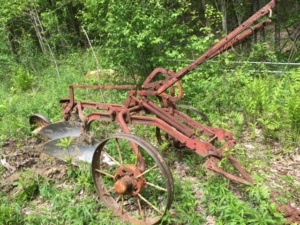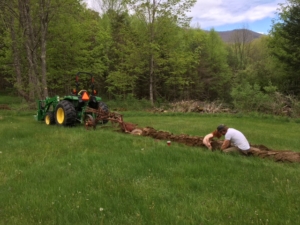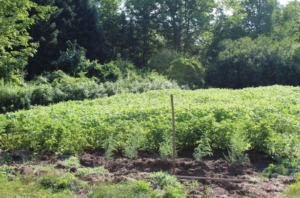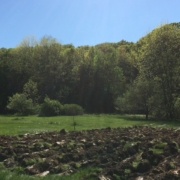Turning a Patch of Lawn into a Vegetable Garden, Part 1
Like many people, I decided to start a big vegetable garden in the Covid spring of 2020. The goal was a garden on the cheap – a couple hundred bucks was the rough budget agreement with my partner.
I went the traditional rectangle-on-the-ground route, as opposed to raised beds, because I didn’t want to have to buy or make lumber and I didn’t want to have to dig and elevate soil. I’m blessed with a big backyard so space isn’t an issue. I know the ground is fertile because I had it tested at UVM: here’s the link to follow if you want to do that with your own soil. For $15 they’ll send you back an analysis that tells you what it has and what it needs; for a few dollars more they’ll test for heavy metals.
To break the earth, I borrowed a tractor and hooked it up to an old trip plow and a set of disks that came out of a hedgerow. I believe the plow was a model called “Little Wonder” that was made by International Harvester in the early part of the 20th century. Hopefully there’s an equipment collector reading this who can correct me if I’m wrong on my ID.

The old plow was elegant; even after years of rust and disuse it worked like a charm. I plowed with my three-year-old daughter, and as you can see from the picture, it was slow going, since we needed to get off and pull worms out of the furrows with each pass.

The rectangle ended up being about 30 x 70, which seemed right. The thinking here was that if I’m going to go through all the trouble of putting up a deer fence, it may as well fence in a large area. A big footprint will give me the ability to scale up or scale down based on the time and interest available in any given year. And if it turns out to be too big to manage, then I’ll plant some fruit trees within the fence, or keep animals in there.
If I didn’t have access to heavy equipment, I might have tried weakening the sod with landscape fabric, then smothering it with cardboard and mulch for a year. This fits into the no-dig garden concept that’s all the rage amidst a certain subset of home gardeners. I’m intrigued by no-dig techniques, especially by the idea that you’re not using machines to compact your soil, and you’re not exposing more bare dirt than you need. On a small scale it makes a lot of sense to me. But the logistics of trying to do a 2,000 square foot garden this way were too daunting. Plus we all work with what we have, and in my case it’s easier to borrow a tractor and coax some old machinery to life than it is to try to source industrial rolls of cardboard and gobs of mulch.
In year 1, after breaking the earth with a plow and disking it, I mostly resisted the temptation to start planting and instead cover cropped for a year. Lawn sod takes a long time to break down. And the soils under lawns are compacted, which plants don’t like. And there are white grubs, and crabgrass, and other garden pests that get stirred up by disturbance but can be blunted with time and technique.
To cover the exposed soil I planted buckwheat, which is cheap. It took maybe $10 worth of seed to cover the rectangle. Buckwheat grows fast, so it’s a good smother crop which keeps the weeds down. It has deep roots, which helps loosen the compacted soil. It can add phosphorous to the soil, but since I just let it die and fall over, I probably missed this benefit. Still, the dead thatch protected the soil all winter, and in the spring of 2021 I had a nice, loose rectangle of earth to work.
The story continues in Part 2 of the blog . . .

The garden plot in late July, 2020

